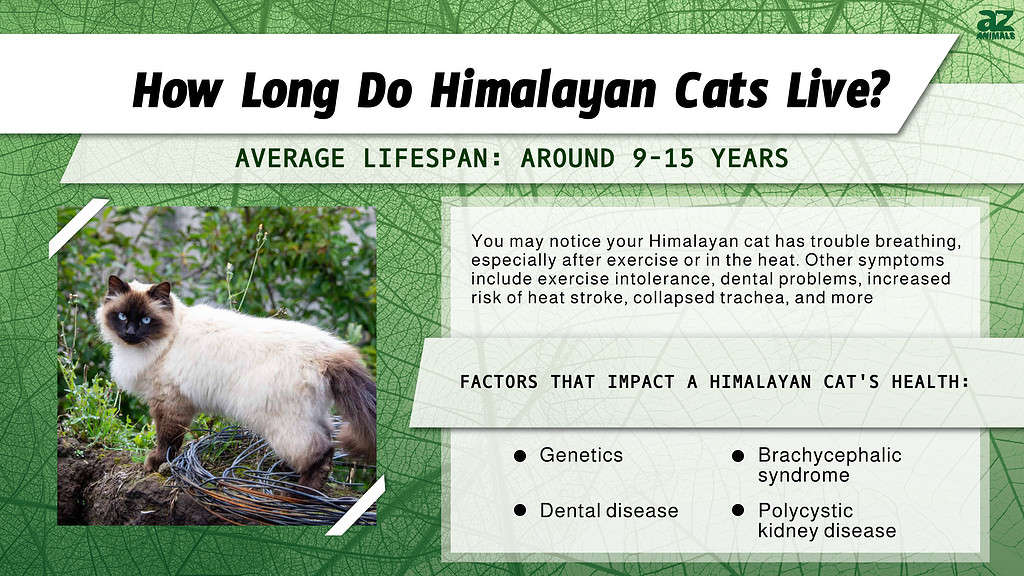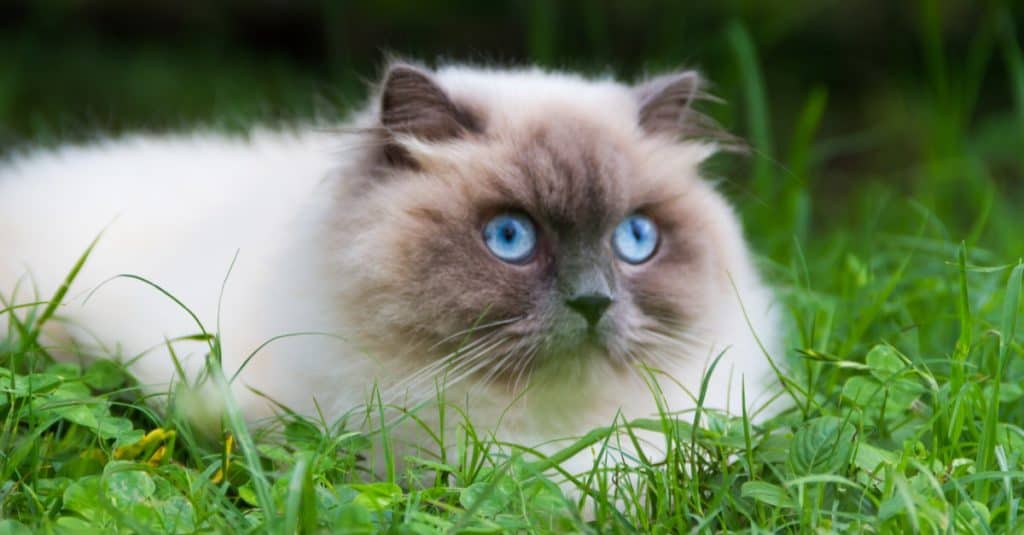Himalayan cats were originally a crossbreed between Persians and Siamese cats in the mid-1950s. They have calm temperaments, long fur, and squished faces.
Himalayan cats live around 9-15 years on average. Some live well into their twenties, while others live much shorter lives. The average lifespan of domestic cats has only increased in recent years as advancements have been made in cat food and veterinary care.
In this article, we’ll discuss how long Himalayan cats live on average, what their life cycle looks like, and how to keep your Himalayan alive and healthy for as long as possible!
How Long Do Himalayan Cats Live?

On average, Himalayan cats live 9-15 years.
©iStock.com/Louis-Michel DESERT
Himalayan cats typically live around 9-15 years. They have similar lifespans to other domestic cat species.
However, Himalayans may suffer from more health issues than other cats throughout their lifetimes due to their short snouts. They will likely have difficulties breathing and other related health problems.

The Average Himalayan Cat Life Cycle

Himalayan cats have different needs during different life stages.
©iStock.com/Zareen Johnson
Newborn-Eight Weeks
Himalayan kittens are born completely dependent on their mothers–or human foster carers if they’ve been orphaned. They cannot even potty on their own yet!
Their eyes and ears are closed, so they have little sensory input. However, they can cry and purr.
By the time they’re a week old, Himalayans will have opened their eyes, and their ears will begin unfolding. They still won’t have great senses of hearing or sight, but they will be able to move around a bit.
Week three is a big one: Himalayan kittens can be sexed, use the litterbox, and eat kitten food. They’re not yet weaned and still don’t venture far from their mother, but they will begin to learn how to play! Their senses of sight, hearing, and smell continue to develop.
The fourth week begins a crucial socialization period in Himalayan cats’ lives. They should be learning to interact with other cats and humans.
This is also when Himalayan kittens will start weaning, a process that will be complete by the time they’re six to eight weeks of age.
At two months of age, most kittens’ eyes change from blue to their true color–but you won’t see this in Himalayans since their eyes are always blue!
Kittenhood
Most people don’t meet their Himalayan cat before this time or even later in life! This is because kittens should never be separated from their mother and siblings until they’re at least eight weeks old.
From two months onward, kittens still have a lot to learn. It’s important that they have other cats to interact with, as cats are social animals who prefer the company of others. This is why it’s recommended to adopt two kittens at a time, not just one.
Even in households with an older cat, two kittens can keep one another occupied, teach one another how to behave, and get out that kitten energy. Many older cats don’t want to be pestered and don’t have the energy to keep up with a little one!
Kittens adopted into single-cat homes can often develop what is known as “single kitten syndrome.” This isn’t an illness, but a set of behavioral problems that include lack of bite inhibition, inappropriate scratching, and pottying outside of the litterbox. Many of these issues stem from anxiety and stress, while others come from not being taught crucial life skills by other cats.
Of course, it’s also vital to socialize kittens with humans during this stage of their lives. They should learn how to play nicely with toys, not with hands or feet. Teach them life skills such as accepting grooming, teeth brushing, nail trims, and more.
Himalayan kittens should be spayed or neutered before four months of age, especially if living with other unneutered cats of the opposite sex.
Himalayan cats aren’t considered adults until they’re one year old, but they reach sexual maturity much sooner. Cats can mate as young as four months old, though it isn’t healthy for them to have kittens this young!
Adulthood
At one year of age, most Himalayan cats will still be full of kitten energy. This will likely last until at least six years of age, and potentially longer. Most cats’ energy levels taper off gradually throughout adulthood.
Of course, Himalayans are known for their calm, laid-back personalities. You’ll likely get just as much snuggle time as playtime out of them–but they still need exercise just like any cat!
You’ll also want to pay extra attention to your cat’s weight at this age. Many will become overweight, especially after being spayed or neutered. Talk to your veterinarian about which cat food to feed your Himalayan and in what amounts.
Senior Years
There are varying opinions on what age a cat becomes a senior, with starting points varying from seven to 11 years.
Senior Himalayan cats will likely move more slowly than they did in their younger years. They may lose weight or develop health problems such as arthritis.
It’s extra important to keep on top of your senior Himalayan’s health. They should see a veterinarian once every six months for a checkup, and more often if you notice signs of illness.
Don’t spend your kitty’s senior years fretting, though–make sure to enjoy this time together, and remember that even seniors often have a lot of life left to live!
Factors that Threaten the Himalayan Cat’s Lifespan

Factors that can reduce a Himalayan’s lifespan include poor genetics, health problems, and being allowed to wander freely outdoors.
©Anna Krivitskaya/Shutterstock.com
Genetics
Genetics plays a large role in how long any animal lives. With rescues, we don’t have control over this factor–but if you’re adopting from a breeder, it’s crucial to shop responsibly.
Reputable breeders should complete all recommended health testing to ensure their line isn’t passing down genetic ailments. They won’t breed animals who have genetic conditions.
Unfortunately, this means there are no reputable Himalayan breeders because this breed is brachycephalic (short-snouted). Their breeding is, unfortunately, focused on appearance over health.
I highly recommend opting for a rescue cat (either a Himalayan or another breed) or purchasing a different breed from a reputable breeder. You may be able to find purebred cat rescues near you if you want to adopt a Himalayan cat without supporting unethical breeding.
It’s important to do your research into the breeder or rescue you’re adopting from, and always adopt responsibly!
Health Problems
Health problems Himalayan cats are prone to include:
- Brachycephalic syndrome
- Eye issues
- Dental disease
- Polycystic kidney disease
- Heart disease
- Feline hyperesthesia syndrome
Himalayan cats’ primary health issues are due to poor breeding. They can suffer from brachycephalic syndrome, which is a collection of symptoms that occur due to their shortened snouts.
You may notice your Himalayan cat has trouble breathing, especially after exercise or in the heat. Other symptoms include exercise intolerance, dental problems, increased risk of heat stroke, collapsed trachea, and more.
Their large eyes can also cause eye issues in the breed. The Himalayan breed was originally a cross between Persian and Siamese cats, and Siameses also have a predisposition to eye problems.
Himalayans are also prone to polycystic kidney disease, which is when cysts form on a cat’s kidneys, sometimes leading to kidney failure.
The breed may suffer from heart disease, either at birth or later in life, or feline hyperesthesia syndrome–very sensitive skin, usually on the back, that can cause a cat to bite or scratch itself, cry, drool, or show other signs of discomfort.
Going Outdoors
Outdoor cats harm local wildlife populations, and also themselves and each other. Risks to allowing your cat outdoors include:
- Cars
- Predators
- Cat fights
- Disease
- Parasites
- Injury from falls or getting stuck in undesirable places, such as in trees
- Poisoning or other harm from neighbors
- Accidental poisoning (consuming toxic plants or substances)
How to Extend the Life of Your Himalayan Cat

Ways to expand your Himalayan cat’s lifespan include feeding the right diet, providing daily exercise, keeping them indoors, and scheduling regular vet visits.
©Gabriela Bertolini/Shutterstock.com
Feed a Veterinarian-Recommended Diet
Feeding high-quality cat food will improve your Himalayan cat’s health. It’s best to go with a veterinarian-recommended diet, rather than a boutique brand or marketing trends such as grain-free or raw. This ensures they’re eating food that’s been tested and proven to provide the nutrition your cat needs.
It’s also important to feed your cat the right amount of food. Being overweight can shorten their lifespan considerably, and being underweight also comes with health risks.
Remember that treats should only make up 10-15% of your cat’s diet at most, with the rest consisting of their everyday cat food.
Play with Your Cat Daily
Staying in shape is as important for cats as it is for humans. Playing with your Himalayan cat for around 30-45 minutes every day will keep their minds and bodies active well into old age.
This play should be broken into 10-15 minute sessions before mealtime and before times you’d like your cat to sleep, such as while you’re at work or sleeping yourself.
Playing gets cats up and moving and also simulates hunting. It’s very enriching for their brains! It’s vital that cats get to exhibit natural behaviors like this, but preferably without hurting actual wildlife.
Keep Your Himalayan Cat Indoors
Perhaps the most significant thing you can do to increase your Himalayan’s lifespan is to keep them indoors or to allow only supervised or enclosed outdoor time.
When cared for properly, indoor cats are healthier and happier, because they don’t have to experience the stress that comes from an outdoor lifestyle.
But if you want your cat to experience the outdoors safely, work on harness training them so that you can bring them out on a leash. Or, build a catio (cat patio) where they can experience nature but still be contained.
Yearly Check-Ups at the Veterinarian
Lastly, bring your Himalayan cat to the veterinarian regularly. Young cats should see the vet at least once a year for a check-up, while seniors should have a wellness visit once every six months.
Veterinarians notice things the average cat owner won’t, and they complete testing such as bloodwork to find symptoms nobody can catch with the naked eye. Catching illness early can often be the difference between life and death!
If you notice changes in behavior or other symptoms of illness between visits, schedule an appointment to have them checked out. Remember that cats are good at hiding pain and illness, so we need to take the symptoms that do present seriously. Sometimes, all they’ll show is a slight change in behavior, litterbox habits, or appetite.
Knowing what to look for can help you catch illnesses early and is another way to help your Himalayan live for as long as possible.
Thank you for reading! If you have feedback on this post, please contact the AZ Animals editorial team.
The photo featured at the top of this post is © iStock.com/Louis-Michel DESERT
Thank you for reading! Have some feedback for us? Contact the AZ Animals editorial team.






